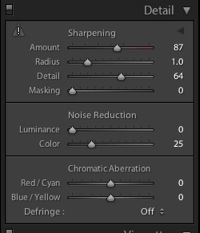First impressions – at last
To read the whole series on the Panasonic G1, click here
The fact that it has taken me three articles to get to the point where I finally try the G1 either confirms that I am a hopeless windbag or discloses how much hope I have for this revolutionary camera. Because I am convinced once electronic viewfinders are done right, the flapping mirror with its attendant vibration plus the heavy and bulky glass pentaprism will be a thing of the past.
If you read on, you will find an unconflicted user opinion – no advertising, no click-through dollars. There are far easier ways of making money and this is my hobby, not my livelihood. What you will find is highly opinionated writing which, let’s face it, is why you come here in the first place.
My goal is simple. I want a digital Leica M without the ridiculous cost and limitations of the M8 which, erroneously in my opinion, has tried to shoehorn 21st century technology into a 1950s body and design.
First impressions are important and my touchstone for comparison is the Leica M2 which, I contend, was the greatest rangefinder camera ever made. Small, fast, superb optics, quiet and unobtrusive, it was never equalled by any subsequent M Leica. Later models added confusing framelines, build quality fell off a cliff, the rangefinder design was compromised rendering it useless for into-the-light photographs, the TTL light meter could only be adjusted at eye level (what were they thinking of?) until the fully auto-exposure M7 came along, and the whole thing went ballistic in price. The Leica M, in other words, had gone from tool to fetish. After 35 years with an M2 and M3 – years which put me in the ‘can use it blindfold’ category and yes, that includes loading film – I really do not need to hear from anyone that I do not know what I am talking about. If you believe that, don’t bother writing and go elsewhere right now.

Same dog, smaller box. Bert awaits the formal opening of the G1
The camera ships with an uncharged battery, which is frustrating as it’s dead without one, but an hour in the charger fixes that. Like everything about this camera, the battery is very small. An hour which is usefully spent with the massive. printed instruction book as the PDF download is frustratingly missing many key pages. I completely blew it on sizing the belt pouch by the way – I bought the Domke F-903 – which is far too small. I shall penitently request a refund from the fine people at B&H.
Once the battery was in the first steps were to get rid of the clutter. This is a street snapper after all.
- Switch off the LCD and keep it ‘face in’
- Switch off the focus confirmation beep – goodness gracious, who needs this?
- Switch recording to 3:2 – Leica format. 4:3 is simply too square for me.
- Switch off all that ‘face detection’ garbage – I know what I’m pointing the camera at
- Switch to Aperture Priority – my preferred setting
- Switch off ‘auto ISO’ and set ISO to 250 – it’s a nice compromise setting for me
- Switch off all the EVF menus – all I want to see is the picture – I managed to get it down to just the A/S indicator (Aperture or Shutter priority), aperture, shutter speed and +/- below the picture frame in the viewfinder. Too bad Panny did not add the remaining picture count. To see that and to get all the other nonsense, a touch on the Display button toggles information overload on and off. The limited display I have opted for is only the third in-viewfinder display which I have found readable – the first two being on the Leicaflex SL (shutter speeds only) and the Pentax ME Super
- Recording is set to RAW + high quality JPG
- Autofocus is set to 23 point matrix, whatever the hell that means. If it’s no good I will try one of the alternatives.
- Focus Priority in the Custom Menu is set Off – the shutter will release regardless of whether the scene is in focus
- The lens cap was discarded together with the gargantuan lens hood and replaced with a B+W 52mm UV filter for protection
- All the complex menus are visible both through the EVF and on the LCD so, in really bright sun, you don’t suffer the frustration (try this with the 5D) of having to find a shaded spot to make changes. Just use the EVF. Pretty special, if you ask me.
- The next one is very special. Surely the single greatest feature of the M2 was the 0.72x magnification viewfinder. The finder frame would appear projected onto the subject – full sun or coal cellar, it made no difference. And the rangefinder rectangle was just as bright and focus simplicity itself. Well, the G1 does not show anything outside the picture taking area, though it is 0.7x in magnification. But its design provides that, when the light is poor, the image is automatically brightened so even in poor light it remains bright. Sure, it gets a bit grainy through the EVF but it is simply illuminated. Magic. This is the sort of thing no conventional mirror+prism DSLR can do
Here are my immediate impressions after inserting the battery and a Sandisk Extreme III 1 gB SD card (that’s a fast, if small, card) with the 14-45mm kit lens fitted:
- Really small and light
- The blue color is very classy and unobtrusive and blue tape on the markings further improves things. I paid for the camera and do not propose to be an unpaid advertiser
- Rubber covering gives an excellent feel, not the divine sensuality of the textured rubber on the M2, but close
- Not so small that my large hands interfere with operation
- Thank goodness for the eyepiece diopter adjuster – it has a large range and I can set it just so
- I wear glasses and have no difficulty seeing the whole screen through the EVF
- Zoom ring on the lens feels OK – could be smoother. That’s what happens when you trade Leitz’s beautiful, low friction, heavy brass helicoids for plastic with stepper motors
- Switch-on is instant
- The EVF illuminates instantly when the camera is raised to the eye, courtesy of the eyepiece proximity sensor
- The front control wheel is a little strangely placed but something I can get used to. In aperture or shutter priority it is used to adjust the aperture and shutter speed. Depress it toward you and the function toggles to under/over exposure adjustment – wonderful thinking by the designers!
- The EVF looks great indoors but a little blown out outdoors – something I need to adjust
- EVF blurring with motion is insignificant and the definition is absolutely, bloody wonderful. There are slight moiré patterns visible in the EVF with textured subjects but I do not find the effect particularly objectionable.
- Autofocus is instantaneous – feels like the 5D in that regard
- Shutter response is almost equal to the Leica M2 – and as there’s no need to set focus, the overall responsiveness is superior
- READ THAT AGAIN. Shutter response is almost equal to the Leica M2
- The shutter is marginally louder than the M2’s – little in it. A huge feature for me. As I have learned with the LX-1, complete silence is not a good thing – you are never sure if you have pressed the button. Will the shutter’s noise embarras you or draw undue attention? No.
- The viewfinder screen blackout after pressing the shutter release is very noticeable, but I’ll trade that for the shutter response any day
- To avoid 2-3 second delays between snaps, I switched Auto Review to Off, thus making snap-to-snap times very short. 2 or maybe more a second seems feasible. The picture review is projected on both the EVF and the LCD and is simply unacceptable and, for me, quite unnecessary. You are hardly going to stop to review pictures on the run, after all. The camera will still be writing out the first file to the SD card while you are taking the second picture, but the EVF remains available during this process – and I’m talking about taking RAW + HQ JPGs (10.5 + 4-5.5 mB)
- With the top left dial set to Manual Focus, turning the focus collar on the lens immediately magnifies the image for a very usable full area focus screen as seen through the EVF. Is it as good as the microprism in the Leicaflex SL? No. Nothing is. But it’s close.
A few words about processing RAW files.
I store Import settings in Lightroom 2 for my various cameras – currently the 5D and LX-1. So into LR2, Develop->New Preset with the following tentative settings:

This is a high level of sharpening but entirely appropriate. Panasonic, thank goodness, like Canon with the 5D, have used a very weak anti-aliasing filter (corrects ‘jaggies’). This leaves the user to make sharpening adjustments and gives maximum flexibility. The above settings were determined after looking at imported RAW files 1:1 on my 24″ iMac’s screen.
As for in the field operability and picture quality, that will have to wait for the next installment. Here’s an early grab shot.

At the florist. G1, 14-45mm @ 18mm, 1/40, f/7.1, ISO 320, 16:9 RAW original processed in LR2
And another:

At the library. G1, 14-45mm @ 16mm, 1/25, f/7.1, ISO 320, 16:9 RAW original processed in LR2
Meanwhile I am optimistic. Panasonic, along with Sony, Canon and Samsung (Pentax), is one of the very few companies with the capital and electronics know how to create an essentially new camera for the twenty-first century. A small, quiet, fast SLR (or whatever you choose to call it) with a large sensor and with compact interchangeable lenses at a very reasonable price. The Electronic View Finder is the future and you can have it now in the G1, perhaps the first really usable execution in a consumer priced camera. Durablity? Who cares? You can get ten of these for one M8 and the only viable alternative is Panasonic’s GH1 which, while adding a movie mode for a few hundred dollars more, is otherwise identical.
Firmware: My G1 shipped with v1.0; Panny just announced v1.3 details here. Installation simply involves copying the firmware download to a freshly formatted SD card and starting the camera with a fully charged battery. Be aware that v1.3 prevents the use of aftermarket batteries. For me the most useful changes are in v1.1 – adjustment of the EVF/LCD color cast is permitted and the enlarged view in Manual Focus mode no longer switches off after a time out.
> Switch off all that ‘face detection’ garbage –
> I know what I’m pointing the camera at
But does the autofocus matrix “know” what you are pointing at. Or is the word “GLASS” really the most important thing in your florist grab shot. I am suggesting that “Face detection” may be Just Enough Automation when relying on autofocus in the same way many of us prefer Aperture Priority as Just Enough Automation.
It is my impression that cameras have become like fly-by-wire jet liners. The pilot no longer flies them – but only makes enough suggestions to the computer so that it can do a better job.
In a similar vein, sometimes I think I would like a programmed Aperture Priority – in which ISO is adjusted instead of the shutter at the slower shutter speeds.
Interesting you should mention that, Andy. I am no fan of these systems and, coincidentally, before reading your comment had changed the camera to central rectangle focusing with first pressure on the shutter button locking in focus. Your comment is spot on for this old fart who grew up setting just three things – shutter speed, aperture and focus. I think the new Pentax K7 has what you mention – the AE variant.
I don’t think the 23-area autofocus matrix knows what you point at. In my experience, it just focuses at random stuff, and tells you “hey, these highlighted areas came out in focus.” I just use the 1-area focus mode, center the focus area, and focus hold. On tripod shots, however, I find that all I use is manual focus.
Thomas: you may want to give the Auto ISO a try. I just set the Auto ISO limit to 800 and use P mode, exposure compensation and program shift. Aperture priority should work as well, of course.
One thing that I didn’t notice you mentioning: live histogram in viewfinder. It sounds neat, but I find it’s a bit obstrusive (it could use being semi-transparent) and not as useful as it sounds (I’m pretty impressed with the metering on this camera).